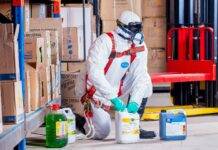
Chemical Process Safety Notes: Ensuring Safe Operations in Industries
Chemical process safety is paramount in industries dealing with hazardous materials. It encompasses various measures aimed at preventing accidents, protecting personnel, and safeguarding the environment. Among these measures, chemical process safety notes play a crucial role in maintaining a safe working environment.
Introduction to Chemical Process Safety
Chemical process safety involves identifying, evaluating, and mitigating risks associated with chemical processes. It encompasses a range of activities, including hazard analysis, risk assessment, and implementation of control measures. The ultimate goal is to prevent incidents such as fires, explosions, and chemical releases that could result in injuries, fatalities, or environmental damage.
Importance of Chemical Process Safety Notes
Chemical process safety notes serve as a comprehensive record of the hazards, risks, and control measures associated with a particular process or facility. They provide valuable information to personnel involved in operations, maintenance, and emergency response. By documenting relevant details and procedures, these notes help ensure consistency, clarity, and accountability in safety practices.
Components of Chemical Process Safety Notes
Hazard Identification
The first step in creating chemical process safety notes is to identify potential hazards associated with the process or facility. This includes identifying the types of chemicals involved, their properties, and any potential sources of release or exposure.
Risk Assessment
Once hazards are identified, a risk assessment is conducted to evaluate the likelihood and consequences of potential incidents. This involves analyzing various factors such as the frequency of exposure, the severity of potential consequences, and the effectiveness of existing safeguards.
Control Measures
Based on the findings of the risk assessment, appropriate control measures are implemented to mitigate identified risks. This may include engineering controls, administrative controls, and personal protective equipment (PPE) to minimize the likelihood and severity of incidents.
Key Elements of Effective Chemical Process Safety Notes
Clear Documentation
Effective chemical process safety notes should be clear, concise, and easy to understand. They should provide sufficient detail to enable personnel to understand the hazards, risks, and control measures associated with the process.
Regular Updates
Safety notes should be regularly reviewed and updated to reflect changes in the process, equipment, or regulatory requirements. This ensures that personnel have access to the most current information and procedures.
Accessibility
Safety notes should be readily accessible to all personnel involved in the process, including operators, maintenance staff, and emergency responders. They should be stored in a central location and easily retrievable in case of an emergency.
Best Practices for Creating Chemical Process Safety Notes
Involving Stakeholders
It is essential to involve all relevant stakeholders in the development of safety notes, including operators, engineers, and safety professionals. This ensures that the notes accurately reflect the hazards and risks associated with the process.
Utilizing Standardized Formats
Using standardized formats and templates for safety notes can help ensure consistency and completeness. This makes it easier for personnel to locate and understand the information they need to work safely.
Training and Awareness
Personnel should receive adequate training on how to use and interpret safety notes effectively. This includes understanding the significance of various hazards and control measures and knowing how to respond in case of an emergency.
Case Studies Illustrating the Significance of Chemical Process Safety Notes
Case Study 1: Chemical Plant Explosion
In 2019, a chemical plant explosion occurred due to inadequate process safety management. Investigation revealed that outdated safety notes failed to accurately reflect changes in the process, leading to critical errors in risk assessment and control measures.
Case Study 2: Reactive Chemical Incident
A reactive chemical incident occurred in a laboratory when incompatible chemicals were inadvertently mixed. The absence of clear safety notes and inadequate training contributed to the incident, resulting in injuries to laboratory personnel.
Regulatory Requirements Regarding Chemical Process Safety Notes
Regulatory agencies such as OSHA (Occupational Safety and Health Administration) and EPA (Environmental Protection Agency) require industries to maintain accurate and up-to-date chemical process safety notes. Failure to comply with these requirements can result in severe penalties and fines.
Challenges in Maintaining Chemical Process Safety Notes
Despite their importance, maintaining accurate and up-to-date safety notes can pose significant challenges for industries. These challenges may include:
- Complexity of Processes: Some processes involve numerous variables and interactions, making it challenging to identify and assess all potential hazards.
- Resource Constraints: Limited resources, both human and financial, may hinder efforts to develop and maintain comprehensive safety notes.
- Technological Advances: Rapid advancements in technology may outpace the ability to update safety notes accordingly, leading to gaps in information.
Overcoming Challenges and Improving Safety Practices
To address these challenges, industries can adopt various strategies, including:
- Investing in Training and Education: Providing comprehensive training programs can enhance personnel’s understanding of process safety principles and their role in maintaining safe operations.
- Implementing Robust Management Systems: Establishing robust management systems, such as process safety management (PSM) programs, can help ensure that safety notes are regularly reviewed and updated.
- Embracing Technology: Leveraging technological tools such as computerized process safety management systems can streamline the process of creating, updating, and accessing safety notes.
Conclusion
Chemical process safety notes are indispensable tools for ensuring safe operations in industries dealing with hazardous materials. By documenting hazards, risks, and control measures, these notes help mitigate the likelihood and severity of incidents, protecting personnel and the environment.
Chemical Hygiene in Laboratories: Promoting Safe Handling and Storage Practices
Chemical Handling: Storage and Personal Protective Equipment (PPE)
Chemical Exposure Monitoring: Air Sampling and Analysis
Chemical Spill Response: Containment and Cleanup
Hazardous Materials Transportation: Compliance and Emergency Response
FAQs (Frequently Asked Questions)
1. Are chemical process safety notes mandatory for all industries?
- Yes, regulatory agencies require industries dealing with hazardous materials to maintain accurate and up-to-date safety notes.
2. How often should safety notes be updated?
- Safety notes should be updated regularly to reflect changes in the process, equipment, or regulatory requirements.
3. Who is responsible for creating and updating safety notes?
- Various stakeholders, including operators, engineers, and safety professionals, are responsible for creating and updating safety notes.
4. What are the consequences of not maintaining accurate safety notes?
- Failure to maintain accurate safety notes can result in severe penalties and fines from regulatory agencies.
5. How can industries improve the effectiveness of their safety notes?
- Industries can improve the effectiveness of their safety notes by investing in training, implementing robust management systems, and embracing technological solutions.
























